I have found myself playing a lot of Hostage Exchange in the past little while. In this article I will be giving an overview and some tips on how to play this newer objective card.
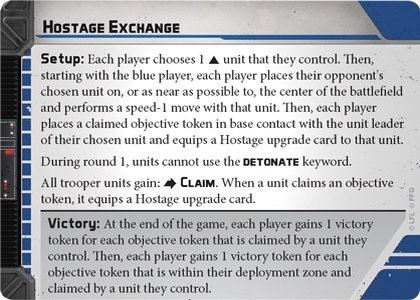
Turn 0
Before you ever find yourself setting up for Hostage Exchange there comes the pre-game ban phase. When should you put Hostage Exchange in your deck? The lists that want Hostage Exchange in their decks are force users, and lists that have movement shenanigans. When should you ban to, or ban away from Hostage Exchange? If you have one of those things and your opponent doesn’t try to play hostage, if the opposite is true, try not to play hostage. You should also being paying special attention to the deployment if Hostage Exchange is a possible objective. Look for how far the deployment zones are away from the center which may affect movement shenanigans. Also look at what path you want your hostage to take on the battlefield. Speaking of deployment zones, try to prevent hemmed in if you are red player, it will be an uphill battle, depends on terrain though.
Now that you find yourself with a Hostage Exchange game, how do you setup? This, of course, depends heavily on your list type. But, generally, you want to cover the center of the battlefield. Especially if you’re running a gun line you want to make sure you can bring your guns into range early, especially if you are red. Also be very conscious of the various shenanigans you and your opponent can pull. Make sure to get your ranges right. Also, be careful of where you move and cohere your opponent’s minis right off the bat. Try to move and cohere them away from your opponent’s side of the board to limit shenanigans, but also be careful if you want to infiltrate units, the hostage unit counts as an enemy unit so you can’t infiltrate inside range 3 of it.
Hostage Exchange Overview
Basically, both players are going to move their hostage the first turn, some armies can move their hostage further than others. At the start of turn 2 is when the action usually kicks off. Whoever has priority can choose to move their hostage to get them safer, or, attempt to stop the enemy’s hostage leaving their hostage vulnerable. Generally, red needs to be aggressive here, as, if both hostages get away then red needs to kill something which can be hard if blue retreats away. Generally, if you are blue then your priority is getting your hostage to safety, if you are red then making your opponent drop their hostage is the priority.
If two gun lines play hostage you can often see a big fight in the center as both armies try to annihilate the other. Be careful if you find yourself in this situation to always keep a mental note on the points destroyed for both players. Knowing if you are winning the tie-breaker or losing it will help you make decisions on what you need to do.
Movement Shenanigans
There are a variety of movement shenanigans that are extremely powerful in a game of Hostage Exchange. These fall into two broad categories, as well as a unique one.
The unique one is Captain Rex who can use his Scouting Party ability to give his own hostage a big movement boost right off the bat. If you see Rex in the other army be warned. You can limit this by banning to a deployment that prevents rex from getting in range to use scouting party, (Long March and Roll Out for example.) Also, if you are playing against Rex then likely you are playing against a very powerful gunline. Make sure to look closely at the terrain to find spots for you army to hide, losing units to a clone army off the bat is never good. Also look to potentially do a bunch of damage to Rex early if you are able to. Lots of times Rex will have to expose himself a bit to use Scouting Party. If you have a powerful alpha-strike unit, that’d be the time to use it.
One category of movement shenanigans is command cards that give movement. These include No Time for Sorrows and You Serve Your Master Well. Any command card that can provide an extra move should be used to get your hostage back into your lines as quickly as possible.
The other category is actions that can provide moves to other units, Pull the Strings and Guidance come to mind. These can be used in any turn to get the hostage into your lines. Importantly they can be used multiple times, characters with these abilities are quite good at hostage. Palpatine in particular is able to get his own unit safe and use give in to your anger to guarantee “priority” during the second turn. Palpatine also wants to be able to nuke units in the center of the map which is often possible during Hostage Exchange.
A trick that can be very useful with movement shenanigans is to cover up the center of the battlefield to force your opponent to take a circuitous route and not maximize their movement first turn.
In this following picture you can see how the two hostage units looked after turn 0.
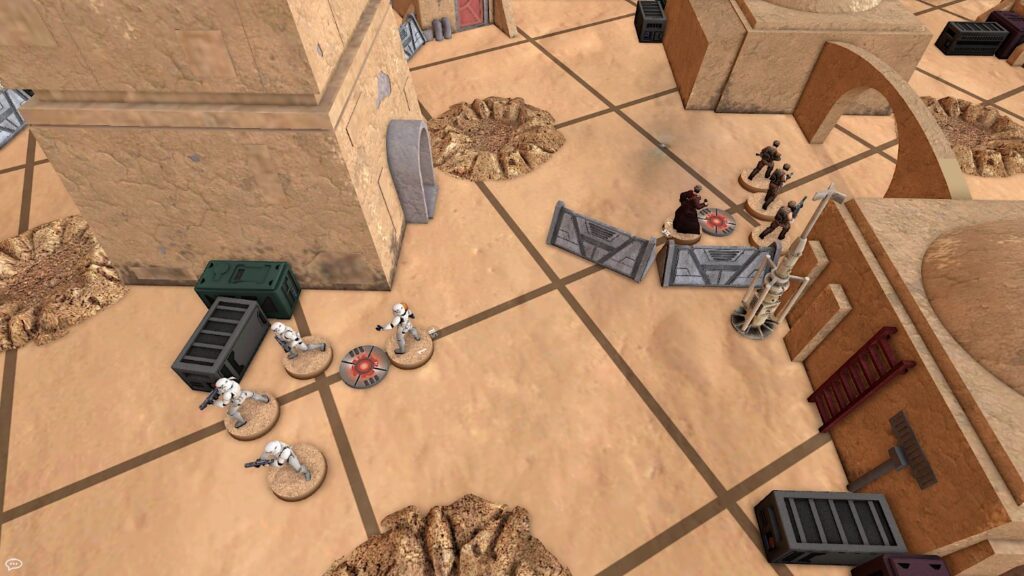
In this next picture you can see that the rebels were given an order with No Time for Sorrows and so have now covered the middle of the map, limiting the movement of the Stormtroopers, they will activate after the enemy Stormtroopers to still get their two moves.
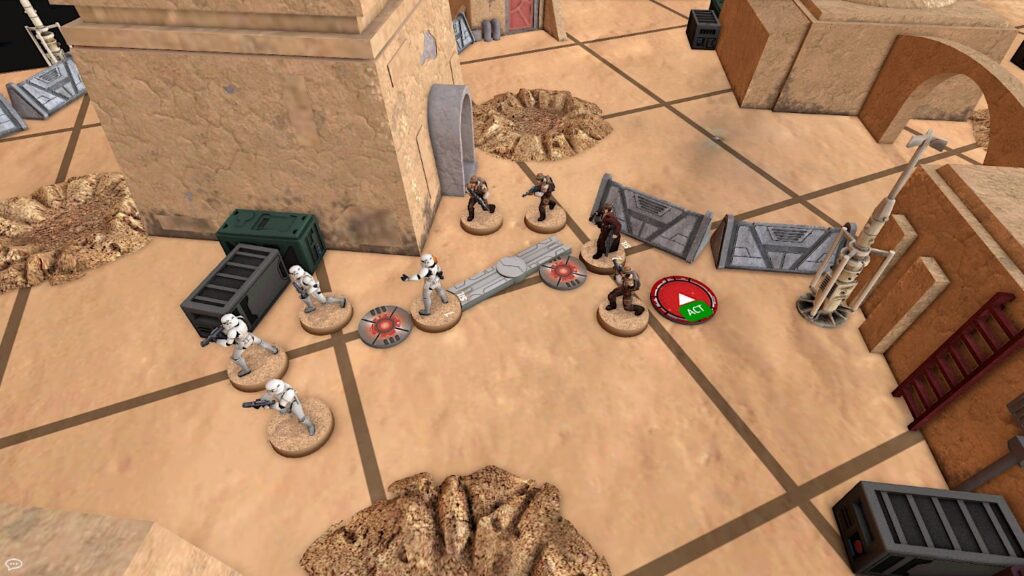
This trick can help limit the opponent’s hostage squad a few inches which can make it a lot easier for your guns or force user to get to them. This effect can be especially prominent when using B1 battle droids as your hostage unit as you can have up to eight models blocking movement in the center.
Whenever you are building a list take a moment to consider Hostage Exchange in regards to your command hand. Always consider taking cards that give free movement. Generally cards that give moves are powerful and taken regardless but sometimes they’re left behind, (specifically R2-D2s 3-Pip.) If you have a card that is able to give you a free move then you automatically have an advantage for Hostage Exchange, (not to mention that those cards are powerful in most games.)
Force Users
Force users are their own unique beast on Hostage Exchange. As moving a unit is literally the main objective, force push is incredibly powerful. Force push plus other shenanigans is even more powerful. A lot of the general use information about force users is extremely applicable to Hostage Exchange and can be read or listened to elsewhere. One very important thing to know when playing with or against force users on Hostage Exchange is that you can use force push to move an enemy unit speed-1. Then you can cohere at least one model as far backwards as possible before going into melee with them. This can ultimately drag an enemy hostage unit backwards ~8 inches.
A very important thing to look for when you are playing with or against a Force User on Hostage Exchange is what the terrain looks like on the middle of the map. If there are Line of Sight blocking pieces near the middle then a Force User has a good opportunity to get to a Hostage carrying squad first activation of turn 2 and still be safe. If you engage a Hostage squad top of turn 2, they are likely to withdraw from you which, if that leaves a Force User in the open, could be game over for that Force User.
Let’s know look at some force users in particular.
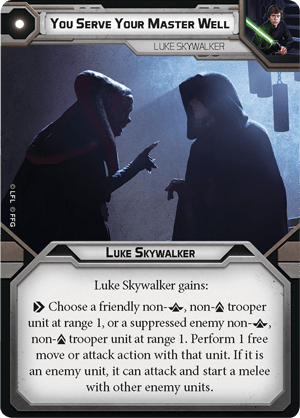
Luke Skywalker, in both his commander and operative variants can be incredible on Hostage Exchange. One thing that Luke is fairly unique in doing is being able to get to the opponents hostage while getting your own to safety. This can be achieved with his command card You Serve Your Master Well.
This card can allow Luke to move your own hostage to more safety while he engages the opponent’s hostage. You can also use Serve to move your opponent’s hostage carrier as well, especially if you have Jedi Mind Trick. Depending on the situation either of these plays can be amazing. Also you can consider using You Serve Your Master Well in combination with Force Push to really move an enemy unit around. You could use the command card free action to move an enemy unit at Speed-1 (because of the hostage slowing them down) then cohere a mini backwards, engage the back mini. Then, Force Push the unit, again cohering a mini backwards and re-engage them. This would move the enemy’s unit over range 2.
Count Dooku can also move an enemy unit with his 3 pip, You Disappoint Me. Dooku is just a great area control piece in general which is great for Hostage Exchange.
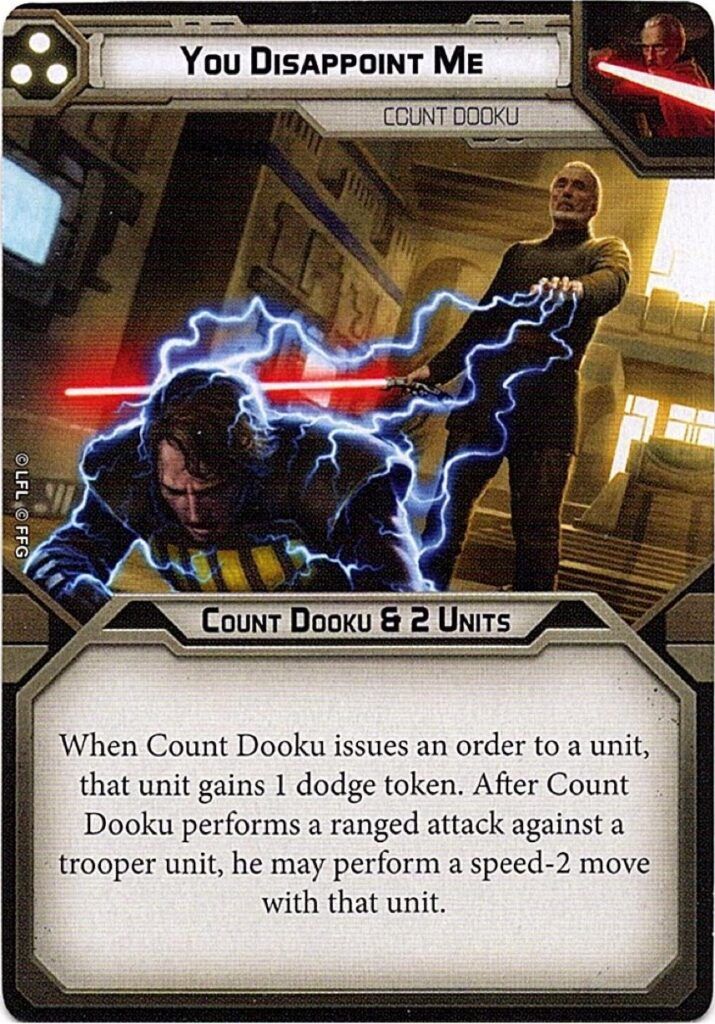
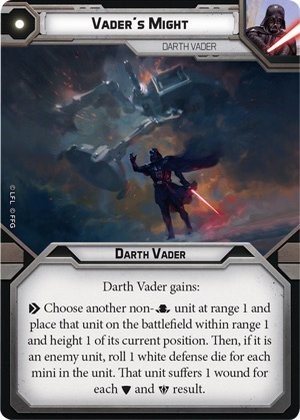
Arguably the best force user for Hostage Exchange is Operative Vader. This may sound ludicrous but listen to this. Play Vader’s Might, also have Burst of Speed and Force Push. First action is to move and relentless the enemy unit with Force Throw, this will allow you to Scatter the enemy unit. The placement of Vader is crucial. You want to be placed so that when you Scatter the enemy unit Vader will be at range 1 of the mini you cohere towards yourself, so just under 10 inches from the unit leader of the enemy unit. Next this is to use Vader’s Might the enemy unit to place the unit leader within range 1 of the mini you cohered towards you, (so basically in melee with Vader.) Then you Force Push the enemy unit and cohere the enemy unit so Vader can Speed-3 (with Burst of Speed) to engage the enemy unit. This should result in moving the enemy unit’s leader about 18 inches. This will likely place the enemies hostage in your deployment zone and put the game firmly in your hands.
A Force User that is likely to be very good at Hostage Exchange is Yoda. Yoda can use his 1-pip to be able to use Guidance twice in one turn so that you could move a hostage unit four times in one turn. You could even potentially have Padmé to have access to her 2-pip to get a command card to provide a free move.
One final note about specifically dark side force users (and Anakin) is that you can take Force Choke. This means that you can choke a hostage carriers unit leader to force the unit to drop the hostage. Combined with Force Push you could push an enemy unit into your Force User, then choke the unit leader, and then take an action to pick up the enemies hostage. If you see Force Choke in your opponent’s list then consider making a two health unit leader carry your hostage to help mitigate this play.
Honorable Mentions
Basically when you are thinking about units/lists that are good at Hostage Exchange, think about if this unit/list is good at Recover the Supplies. Often those two objective require similar abilities. So basically hardy units that can move.
Also, as recently mentioned on a Notorious Scoundrels episode, vehicles can do some wacky things on Hostage Exchange. Of specific note was AA5s making a “V” basically surrounding the enemy hostage so that they couldn’t move back towards the deployment zone. So never discount vehicles even in this trooper centric objective.
Final Thoughts
Hostage Exchange is an objective that you need to play a few times to get a grasp of in my opinion. There’re many shenanigans you can use or avoid to increase your odds of winning.
My biggest piece of advice, never attack with your hostage unit unless it has a free attack, or it’s a B2 unit.
Hostage Exchange is also an objective that can yield some fun hobby projects. For example, I have Baby Yodas that make some great hostages. If you have a 3D printer or a friend with once you can make some really cool hostages that can also be used for good thematic play.
Cheers,
Timbo
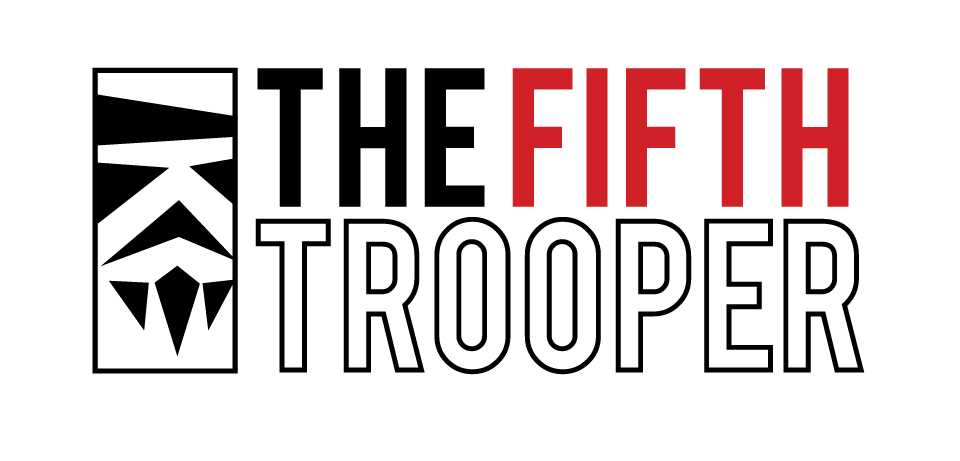
Thanks for a good article!
Thanks